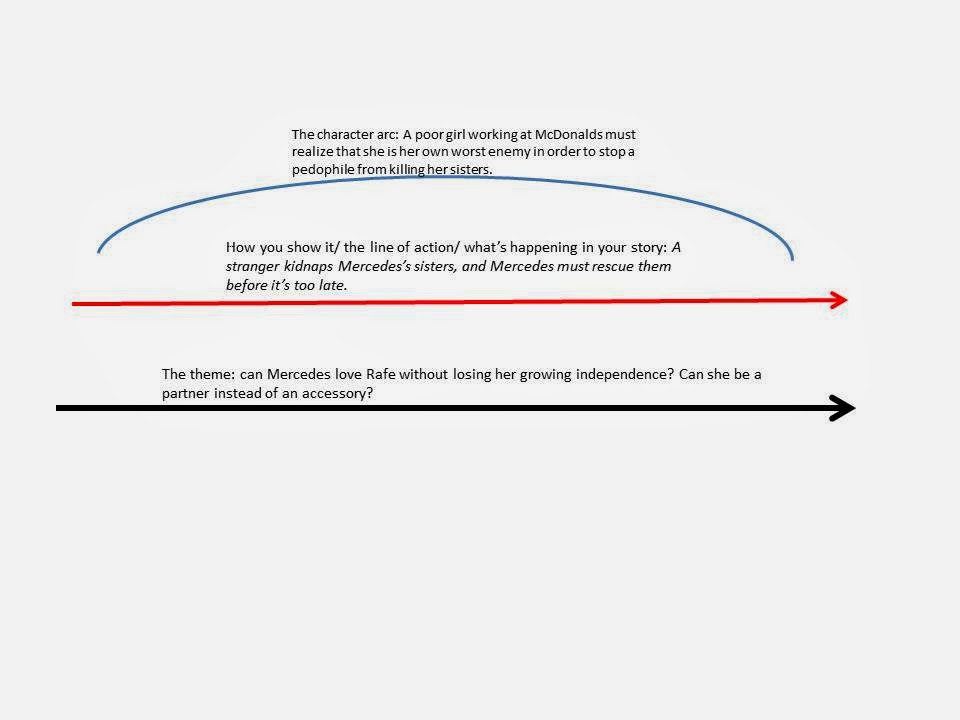I came across this powerpoint yesterday while I was cleaning
out a workshop and fell in love with it all over again. I guess this is where I
admit I fall in love with most of my powerpoints, lol. They’re just so…shiny, and yeah. I'm very much a geek.
This is a schematic I did back when I was solidifying my
thoughts on the arc and how it worked. Until I sat down and took a good, hard
look, I’d always bought into the whole stages and steps things, but the more
study I did into how the arc worked in real-life wips, the simpler I realized
it really was. You can’t impose structure on everything if everything is…well, “everything.”
Some people write huge convoluted things, and some don’t. Which means that any
structure big enough to encompass everything needs to be fairly spare.
You can scale up and scale down, adding
more stages and steps if it works for your comfort level, or strip it down, if
you’re comfortable using three points. Sort of like boats, you know? Some people
love all that GPS and computerized stuff, and some are just as comfortable with
a sextant and the stars. Maybe it's just the way people think and the whole plotter/pantser debate. It seems like a pantser would be good with a sextant and the whole "well, the accuracy is pretty good" while a plotter would be saying, "but it's not 100 percent accuracy. How would you know if you're going to run aground on a reef or something?"
Every character with a transformational arc starts out at pt A, with some kind of
backstory pertinent to the story. And lol!!! Trying to say this cold, not in
the context of a workshop just stopped me, so let’s talk about “backstory
pertinent to a story”.
What is pertinent
backstory and how is it different from “backstory” in general?
Every character has backstory, because everyone has a past. However,
everything in a character’s backstory doesn’t always work for a story. The fact
that I really like Hostess Raspberry Zingers has no bearing on anything 99.9
percent of the time. I’m not sure what it was that caused me to side with
raspberry-coconut instead of chocolate or twinkies, but it only impacts a story
where I’m picking out a snack.
So let’s go back to that statement>
Every character has backstory, because everyone has a past.
Yeah, everyone has a past, but if you don’t narrow it down
to what’s going to drive your character through the story, how will you know
what they’ll do? If I just say Mercedes is this poor kid who works at MacDonald’s
and her sisters were just kidnapped, how will I know Mercedes will fight tooth
and nail to get her sisters back, regardless of how many issues she has? I can’t
give her motivation simply because I say she has motivation. Motivation, along
with conflict, comes from the inside, and that’s where core events come in.
While it might be sort of a cheat to say to that every character
contains a core event in relation to their story, characters need a handle—some
way to work with a character that doesn’t squash them flat and allows them to
grow and change.
One thing I’ve gotten a lot firmer on over the years is the
difference between contemporaries and stories with a heavy dose of external
events, like paranormals, romantic suspense, mysteries and thrillers. I usually
use Kim’s story to talk about emotional structure and Mercedes to talk about
the transformational arc, because they’re vastly different stories. Kim’s
story, being a contemporary, has no big external story arc. Kim needs to open
her bed and breakfast on time, but if push comes to shove, she can do it
without a bathroom in the bridal suite. Mercedes’s story, being a romantic
suspense, has a huge, fast-running external arc. She “needs” to find her sisters
before the villain kills them which means the space between pt A (the way she
starts out) and pt B (her transformational point) is full of scenes that
address three things. The externals (rescuing her sisters), her arc (she needs to stop holding
herself down or she’ll never change in time to rescue the twins) and her
relationship with the hero (since this is a romance). These three things
flip-flop around, depending on what you’re writing. If you’re writing a
mystery, the scenes need to address solving the mystery and the protagonist’s
arc, but not necessarily a relationship of some sort. “However” if it’s a contemporary,
the scenes should address Kim’s transformational arc and her relationship with
Jason, although not necessarily Kim’s battle to fix up the bed and breakfast.
The arc is the blue line on top, the line of action (or how you're showing the arc) is the red line and the black line is theme. All stories have theme, even if the writer is using it subconsciously. It works to keep everything on the straight and narrow, and helps when it comes to figuring out what scenes need to be in the story. And that...is a post for another day.
Granny Jo
Granny Jo











No comments:
Post a Comment